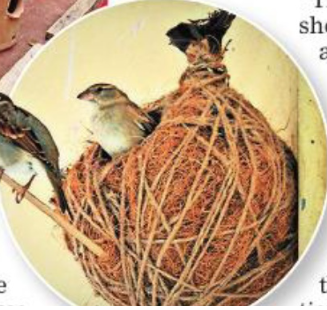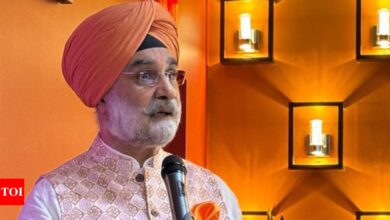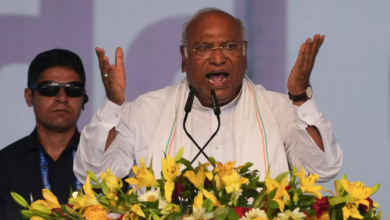India
Igloo-shaped nests to insect hostels: Birders are wooing back the house sparrow | India News

[ad_1]
Wen Nashik-based environmentalist Mohammed Dilawar began making DIY kits for sparrow nests twenty years ago, he had little idea that his efforts would make waves across the country. Dilawar and his organisation Nature Forever Society, were instrumental in pushing the Delhi government to declare the sparrow as the state bird in 2012, and for March 20 to be celebrated as World Sparrow Day.
Since then, the overall population of sparrows in India has been fairly stable, although a country-wide census hasn’t taken place. While the 2023 State of Birds report lists 178 species in the country as being of ‘high priority’ for immediate conservation action, the house sparrow is listed in the ‘least concern’ category of the Red List in The International Union for Conservation of Nature report, which assesses the risk of extinction for different species.
“For the last ten years, we were in the SOS phase of our project. Now, we’re moving to the second phase, and looking at the larger picture,” Dilawar says. In this phase, they have established a native plant research and conservation centre that focuses on studying habitats for house sparrows and other local birds. They’re pushing for the introduction of large-scale native plants and insects in order to create sustainable habitats for the sparrows.
Along similar lines, the Bombay Natural History Society (BNHS) and the Delhi government have set up a dedicated forest area for the birds. Nestled in the Garhu Mandi forest on the banks of river Yamuna lies Goraiya Gram, home to hundreds of sparrows. The pilot project, currently being assessed, may be replicated elsewhere in the country if successful.
“We were trying to create a conducive space for the sparrows to breed and stay year round. Hence, we brought in the right kind of nesting materials, native plants, and a high insect population and diversity,” says Sohail Madan, former assistant director of the BNHS, who helped conceptualise the space.
In the area today, thorny shrubs like ber and jungli gharondas, and grasses like munja, kaas and bajra, which are crucial for sparrows, are planted. There are also ‘insect hostels’ that function as habitats for insects, so that the sparrows have regular feed for their chicks. “Apart from urbanisation and shrinking spaces for the sparrows to live in concrete jungles, we recognised that the dwindling insect population as a result of pruning and using insecticides was a huge problem,” Madan says.
A key takeaway for sparrow saviours is the importance of skilling the next generation and professionals such as architects, in order to create sustainable models of living for the sparrows. Rakesh Khatri, who began making nests using bamboo sticks in 2008, has since then innovated. Through online sessions and workshops in schools, he has reached 12 lakh people, and trained them to make their own nests. He has also conducted workshops for hundreds of architects across Delhi, Mumbai, Bengaluru, and other cities. After all, the changing architecture in cities, which replaced open spaces and roofs with high-rise buildings and compact air-conditioned rooms, was crucial in driving the bird away. The shrinking spaces of roofs, which were ideal for drying papad and rice that served as bird food, has been a factor too.
“Through these workshops, the architects are trained to include spaces for the sparrows while making the map and designs. A builder from Bareilly once took a hundred nests from me, and installed them at the construction stage itself,” Khatri points out. Sadhana Rajkumar, popularly known as the ‘Sparrow Queen’ of Chennai, is focusing on getting the message across to a wider audience. While she started off with distributing wooden nests for the bird at the city’s Marina Beach, she has now moved to ones made from terracotta. “Somewhere along the journey, I asked myself why should I cut down one species (trees) to build a home for another?” she says. In her innovative nests, which are shaped like elongated igloos, the entry point is wide and closer to the bottom, allowing space for the parents of the chicks who often sleep in the nest during early days. There’s also a higher ceiling, allowing room for the chicks to make attempts to fly, so that they don’t get injured. With the help of social media, her nests have today reached over 7,000 homes, including ones in the US and Dubai. Rajakumar also makes bird feeders from waste plastic bottles.
“I have seen the number of sparrows increasing around me, and occupying the nests. Whenever a sparrow comes and makes the nests its home, it makes me realise that I’m fulfilling my life’s purpose,” she adds.
Since then, the overall population of sparrows in India has been fairly stable, although a country-wide census hasn’t taken place. While the 2023 State of Birds report lists 178 species in the country as being of ‘high priority’ for immediate conservation action, the house sparrow is listed in the ‘least concern’ category of the Red List in The International Union for Conservation of Nature report, which assesses the risk of extinction for different species.
“For the last ten years, we were in the SOS phase of our project. Now, we’re moving to the second phase, and looking at the larger picture,” Dilawar says. In this phase, they have established a native plant research and conservation centre that focuses on studying habitats for house sparrows and other local birds. They’re pushing for the introduction of large-scale native plants and insects in order to create sustainable habitats for the sparrows.
Along similar lines, the Bombay Natural History Society (BNHS) and the Delhi government have set up a dedicated forest area for the birds. Nestled in the Garhu Mandi forest on the banks of river Yamuna lies Goraiya Gram, home to hundreds of sparrows. The pilot project, currently being assessed, may be replicated elsewhere in the country if successful.
“We were trying to create a conducive space for the sparrows to breed and stay year round. Hence, we brought in the right kind of nesting materials, native plants, and a high insect population and diversity,” says Sohail Madan, former assistant director of the BNHS, who helped conceptualise the space.
In the area today, thorny shrubs like ber and jungli gharondas, and grasses like munja, kaas and bajra, which are crucial for sparrows, are planted. There are also ‘insect hostels’ that function as habitats for insects, so that the sparrows have regular feed for their chicks. “Apart from urbanisation and shrinking spaces for the sparrows to live in concrete jungles, we recognised that the dwindling insect population as a result of pruning and using insecticides was a huge problem,” Madan says.
A key takeaway for sparrow saviours is the importance of skilling the next generation and professionals such as architects, in order to create sustainable models of living for the sparrows. Rakesh Khatri, who began making nests using bamboo sticks in 2008, has since then innovated. Through online sessions and workshops in schools, he has reached 12 lakh people, and trained them to make their own nests. He has also conducted workshops for hundreds of architects across Delhi, Mumbai, Bengaluru, and other cities. After all, the changing architecture in cities, which replaced open spaces and roofs with high-rise buildings and compact air-conditioned rooms, was crucial in driving the bird away. The shrinking spaces of roofs, which were ideal for drying papad and rice that served as bird food, has been a factor too.
“Through these workshops, the architects are trained to include spaces for the sparrows while making the map and designs. A builder from Bareilly once took a hundred nests from me, and installed them at the construction stage itself,” Khatri points out. Sadhana Rajkumar, popularly known as the ‘Sparrow Queen’ of Chennai, is focusing on getting the message across to a wider audience. While she started off with distributing wooden nests for the bird at the city’s Marina Beach, she has now moved to ones made from terracotta. “Somewhere along the journey, I asked myself why should I cut down one species (trees) to build a home for another?” she says. In her innovative nests, which are shaped like elongated igloos, the entry point is wide and closer to the bottom, allowing space for the parents of the chicks who often sleep in the nest during early days. There’s also a higher ceiling, allowing room for the chicks to make attempts to fly, so that they don’t get injured. With the help of social media, her nests have today reached over 7,000 homes, including ones in the US and Dubai. Rajakumar also makes bird feeders from waste plastic bottles.
“I have seen the number of sparrows increasing around me, and occupying the nests. Whenever a sparrow comes and makes the nests its home, it makes me realise that I’m fulfilling my life’s purpose,” she adds.
#Iglooshaped #nests #insect #hostels #Birders #wooing #house #sparrow #India #News





